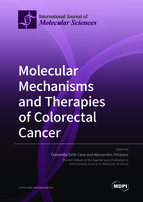Molecular Mechanisms and Therapies of Colorectal Cancer
A special issue of International Journal of Molecular Sciences (ISSN 1422-0067). This special issue belongs to the section "Molecular Oncology".
Deadline for manuscript submissions: closed (30 September 2022) | Viewed by 36848
Special Issue Editors
Interests: pancreatic cancer; cancer stem cells; tumor microenvironment; cancer metabolism; fibrosis; TGF-β signaling; target therapy; drug delivery systems
Special Issues, Collections and Topics in MDPI journals
Interests: abdominal cancers; colorectal cancer; immunotherapy; genomic landscape; neuroendocrine tumors
Special Issues, Collections and Topics in MDPI journals
Special Issue Information
Dear Colleagues,
Colorectal cancer (CRC) is currently the third leading cause of cancer-related mortality. Transforming growth factor beta (TGF-β) signaling have been associated with CRC growth and metastasis, due to its involvement in proliferation, epithelial-to-mesenchymal transition (EMT) and angiogenesis. TGF-β superfamily contains over forty members, including TGF-βs, Nodal, Activin, and bone morphogenetic proteins (BMPs). Three types of TGF-β receptors (TGFβR) have been identified: type 1, 2 and 3. After ligand binding, TGF-βR2 recruits and phosphorylates TGF-βR1 that in turn phosphorylates downstream SMAD (small mother against decapentaplegic) proteins. Phosphorylated SMAD4 translocates into the nucleus where it activates transcription of numerous target genes (including SERPINE1, LTBP2, CDKN1A, ARID3B, ATXN1, PTPRK, RAB6A, SMAD7, EHBP1, etc.) acting predominantly as a tumor-suppressor gene. Interestingly, alterations of SMAD4 are frequent in metastatic CRC and, together with TGF-βR2 genes mutations, have been reported as late events able to promote CRC progression. The study of TGF-β pathway in metastatic CRC is challenging because of great genetic heterogeneity of CRC. However, the increasing availability of targeted and whole exome DNA sequencing techniques make possible to identify genes' mutations in complex, dynamic and heterogeneous clinical contexts and to make correlations with clinical outcome.
This Special Issue was established to prompt researchers to perform studies on:
- Involvement of TGF-β pathway in metastatic CRC.
- Emerging methods to identify and correlate specific TGF-β pathway genes' mutations with metastatic behavior.
- Novel approaches to target TGF-β pathway in metastatic CRC.
- Novel studies to depict TGF-β pathway evolution from primary to metastatic lesions.
Articles consisting exclusively of bioinformatics or computational analyses of public databases or pure clinical studies will not be accepted. Basic studies or translational studies including molecular characterizations of patients from real practice are welcome. Reviews are also appreciated
Dr. Donatella Delle Cave
Prof. Dr. Alessandro Ottaiano
Guest Editors
Manuscript Submission Information
Manuscripts should be submitted online at www.mdpi.com by registering and logging in to this website. Once you are registered, click here to go to the submission form. Manuscripts can be submitted until the deadline. All submissions that pass pre-check are peer-reviewed. Accepted papers will be published continuously in the journal (as soon as accepted) and will be listed together on the special issue website. Research articles, review articles as well as short communications are invited. For planned papers, a title and short abstract (about 100 words) can be sent to the Editorial Office for announcement on this website.
Submitted manuscripts should not have been published previously, nor be under consideration for publication elsewhere (except conference proceedings papers). All manuscripts are thoroughly refereed through a single-blind peer-review process. A guide for authors and other relevant information for submission of manuscripts is available on the Instructions for Authors page. International Journal of Molecular Sciences is an international peer-reviewed open access semimonthly journal published by MDPI.
Please visit the Instructions for Authors page before submitting a manuscript. There is an Article Processing Charge (APC) for publication in this open access journal. For details about the APC please see here. Submitted papers should be well formatted and use good English. Authors may use MDPI's English editing service prior to publication or during author revisions.
Keywords
- Transforming growth factor beta (TGF-β) signaling
- genetic alterations
- molecular targeted therapy
- precision medicine







